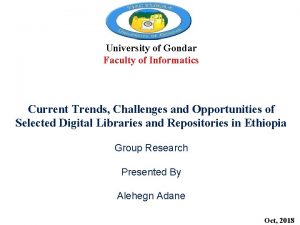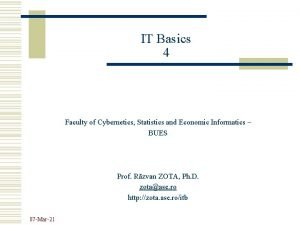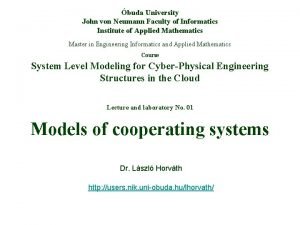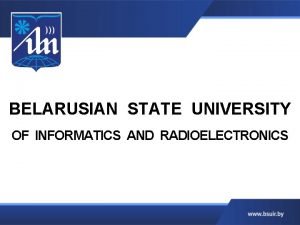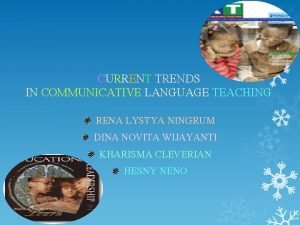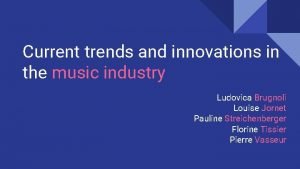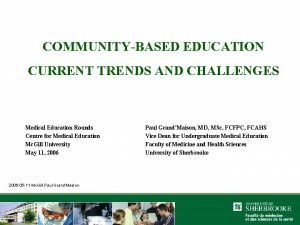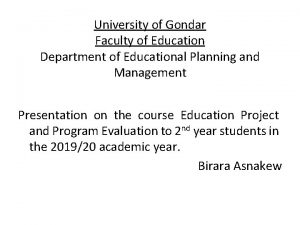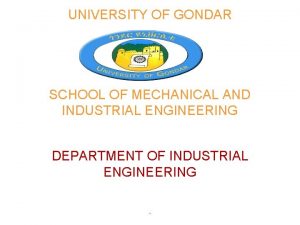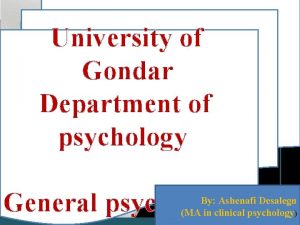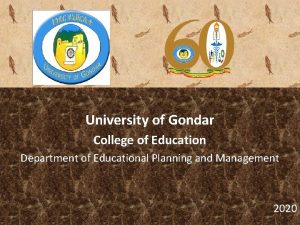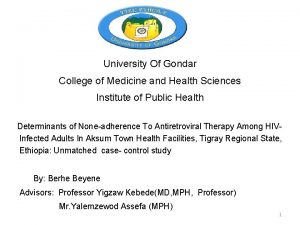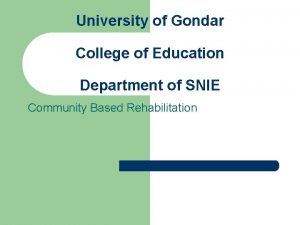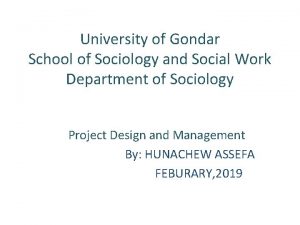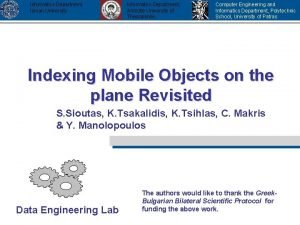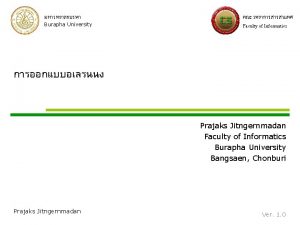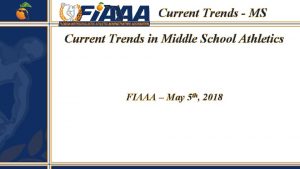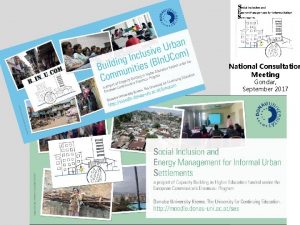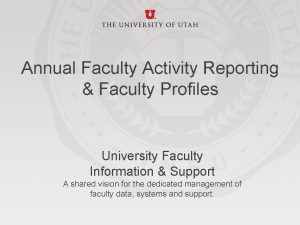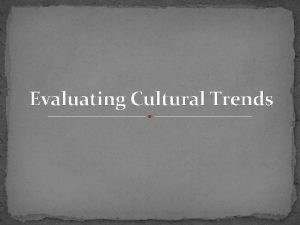University of Gondar Faculty of Informatics Current Trends


























- Slides: 26

University of Gondar Faculty of Informatics Current Trends, Challenges and Opportunities of Selected Digital Libraries and Repositories in Ethiopia Group Research Presented By Alehegn Adane Oct, 2018

Outline • • Background Motivation Objectives Benefits and Beneficiaries Research Methods Results & Findings Conclusion & Recommendation

Background • Digital Library/Repository is an online database of digital objects which may include text, image, video, audio. • In academia, usage of e-resources is growing and sharing academic digital contents is becoming culture. • Recently, digital libraries and repositories have been gaining attention because of its significance.

Motivation of the research • Libraries shift from traditional paradigm into building digital libraries and repositories to meet their customers, • In Ethiopia, public universities and institutions are implementing digital library and repository systems. • But, the implemented systems were not functional in sustainability way • Therefore, this study aimed to explore current trends, challenges and opportunities of digital libraries and repositories in Ethiopia

Objectives General Objective • To explore the current trends, challenges and opportunities of selected digital libraries and repositories in Ethiopia Specific Objectives • To examine the criteria used to select digital library and repository platforms or software • To identify types of digital collections in the selected digital libraries and repositories • To examine the existing challenges that selected digital library and repository faces • To find out opportunities of the selected digital libraries and repositories

Benefits & Beneficiaries Benefits • It enables to identify the constraints in the existing academic digital repository • It serve as an input to build national academic digital library and repository • It enhances the accessibility and availability of recent information in digital libraries and repositories Beneficiaries • Universities, Colleges, researchers, students, policy makers

Research Methods Study Approach and Design • Quantitative cross-sectional survey research method Population Addis Ababa University (AAU), • United Nation Economic University of Gondar (Uo. G), Commission of Africa (UNECA), Bahir Dar University (BDU), • African Union (AU), Jimma University (JU), • Ethiopian National Archive and Haromaya University (HRU), Library Agency (ENALA) digital Adama Science & Technology libraries University (ASTU), • Hawassa University (HU), • • • Digital library staffs and digital library users

Cont… Sampling Methods • Stratified sampling technique (Staffs) – 120 participants • Convenience sampling technique(Users) – 278 participants Data Collection Methods • Structured questionnaire Data Analysis Method • Descriptive statistical methods

Results and Findings Table 1. Selected Digital Library and repository Platforms in Ethiopia Platforms Institutions DSpace AAU, JU, BDU, UOG, UNECA, AU Greenstone AAU, HU, ENALE, ASTU, HRU Bepress AU Eprint UNECA • DSpace and Green Stone are the popular digital library and repository open source platforms in the world • DSpace is the most preferred open source platform used in most digital libraries and repositories in Ethiopia

Results & Findings (Cont…) Figure 1. Selection criteria to select digital library and repository platform Cost Effectiveness Easiness for Installation 2% 11% Consulting Professionals 17% 22% 18% 19% Full Text Accessiblity 11% Interactive User Interface User Community on Web Others • Interactive user interface, full text accessibility and easiness for installation were high ranked criteria.

Results & Findings (Cont…) Figure 2. Types of Digitized Collections 70% 60% 50% 40% 30% 20% 10% 0% tio ta isu is/ di ss er -v A n al s oo k eb ar R ud io Th es ap s /o ld ne w sp og ra ap er s ph s s ri us c an M Ph ot M A rt w pt s ifa ct or k /a er th s/o rn al rt se ri al s u. . . t. D en rn m Jo u s/G R ep o rt oc en ts um ov e ic or ist H C ou rs e. M al do c at er ia ls Percentage (%) • Thesis and dissertations were the most prioritized digitized item followed by rare books, journals and articles

Results & Findings (Cont…) Figure 3. Criteria for selection of materials to digitize collections 80% 70% 60% 50% 40% 30% 20% 10% 0% Historical/Cultural value Commerical Potential Increase Preservation of the User's High demand Academic & Accessiblity of the material Research Purpose material Percentage (%) • Academic and research purpose, increase accessibility, and user’s high demand mostly used criteria

Results & Findings (Cont…) Figure 4. Sources of digital collections Purchasing Internet Donation Instructors/Researchers Other Universities Others • The major sources for the digital collections were from researchers followed by internet and sharing from other universities.

Results & Findings (Cont…) Table 2. Sources of funding for digital activities Funding Organization Percentage (%) Ministry of Education 59. 3 % Governmental & NGO’s 37. 0% Others 3. 0% • The major sources of fund for digital activities were from Ministry of Education followed by Governmental & NGO’s organizations

Results & Findings (Cont…) Table 3. Partnership with other organization for digital library and repository activities Partener Organization Percentage (%) Ministry of Education 4. 2 % Public Libraries 8. 3 % Special Libraries 4. 2 % Academic Libraries 29. 2 % Voluntary Organization 4. 2 % INASP 33. 3 % Governmental & NGO’s 12. 5 % Others 4. 2 % • INASP (International Network for the Availability of Scientific Publications) and Academic Libraries were the best partners for digital library and repository activities

Results & Findings (Cont…) Figure 5. Intellectual property (IP)/Copyright considerations 70% 66% 60% 50% 37% 40% Percentage (%) 30% 20% 17% 10% 4% 0% IP/Copyright issue No IP/Copyright issue IP/Copyright belongs Considered to the institutions No Answer • Copy right and Intellectual Property issues do not considered in the development of digital libraries and repositories in Ethiopia

Results & Findings (Cont…) Figure 6. Types of Users in Ethiopia Digital Libraries and repositories Academic Staff 31% Adminstrative Staff 66% Student 3% • The majority of the users in Ethiopia digital libraries and repositories were students followed by academic staffs

Results & Findings (Cont…) Figure 7. Frequency of Use of Digital Libraries and repositories 17% 1% 29% 19% Daily Weekly Monthly Once a Year Others 34% • 34% of the respondents access the digital library and repository at least weekly followed by 29 % of the respondents use daily

Results & Findings (Cont…) Figure 7. Types of digital collections accessed by users Research Articles & Journals 31% Thesis & Dissertations 27% Course Materials 42% 0% 5% 10% 15% 20% 25% 30% 35% 40% 45% • Course materials followed by research articles and journals followed by thesis and dissertations were the prioritized digital collections accessed by users

Results & Findings (Cont…) Figure 7. Benefits of Digital Libraries and Repositories 60% 50% 40% 30% 20% 10% 0% Can access everywhere rare and anytime expensive collections Can save printing costs Others Percentage (%) • (52%) users for the benefits of access everywhere and anytime followed by (27%) were the benefits of access rare and expensive collections

Results & Findings (Cont…) Table 4. Problems faced while users accessing digital libraries and repositories Problems Low connection speed Low quality of digital collections Percentage (%) 47. 2 % 15. 0 % Links are not working 29. 4 % Others 8. 3 % • Low connection speed and links are not properly working were the major problems while users accessing digital libraries in Ethiopia

Results & Findings (Cont…) Challenges § Lack of copy right and intellectual property right policy § Lack of funds to support digital libraries and repositories § Lack of digital library a plan, policy and procedures § Lack of national open access policy § Incompatibility of digital library and repositories software for local languages § Lack of digital library professionals

Results & Findings (Cont…) Opportunities § It enables document preservation § It increases institutions research visibility § It reduce duplication of work(minimize plagiarism) § It create opportunities for authors, researchers, and students to promote their work § It enhances collaborations among institutions

Conclusion • In Ethiopia, current digital library and repository development activities were found at the infant level. • Absence of digitization policy, lack of funds, incompatibility of software for local languages, and low Internet connection speed are the major challenges. • It enables documents preservation, enhance research visibility, and enhances collaboration among institutions are the major opportunities.

Recommendations • Should have an authorized and structured framework for copy and intellectual property rights • Should have a national digital library and repository policy, plan, standards • Open access policy should be developed • Train digital library human resources • Strong national and international collaborations and consortium among digital library institutions

Thank You!
 Gondar university digital library
Gondar university digital library Cybernetics statistics and economic informatics
Cybernetics statistics and economic informatics Jnfi
Jnfi Belarusian university of informatics and radioelectronics
Belarusian university of informatics and radioelectronics George mason university health administration
George mason university health administration Recent trends in project management
Recent trends in project management Emerging trends in strategic management
Emerging trends in strategic management Lystya
Lystya Current trends in music
Current trends in music Trends of media and information
Trends of media and information Current trends in athletic training
Current trends in athletic training Current trends in medical education
Current trends in medical education Current trends in counseling
Current trends in counseling University of split faculty of maritime studies
University of split faculty of maritime studies University of bridgeport computer science
University of bridgeport computer science Bridgeport engineering department
Bridgeport engineering department Hubert kairuki memorial university faculty of medicine
Hubert kairuki memorial university faculty of medicine Semmelweis
Semmelweis Applied medical sciences
Applied medical sciences Fsu cybersecurity major
Fsu cybersecurity major Faculty of business and economics mendel university in brno
Faculty of business and economics mendel university in brno Singularity executive program
Singularity executive program Agnes csaki semmelweis
Agnes csaki semmelweis Ascaris lumbricoides ova
Ascaris lumbricoides ova Faculty of engineering university of porto
Faculty of engineering university of porto Webkredit cuni
Webkredit cuni Faculty of veterinary medicine cairo university logo
Faculty of veterinary medicine cairo university logo
